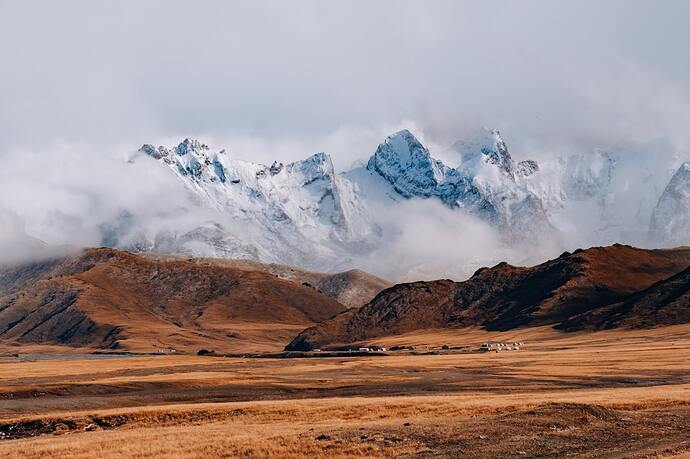Kyrgyzstan, officially known as the Kyrgyz Republic, is a landlocked, mountainous country located in Central Asia. It is bordered by Kazakhstan to the north, Uzbekistan to the west and southwest, Tajikistan to the southwest and China to the east.
With a population of approximately 6.5 million people, Kyrgyzstan is the second smallest country in Central Asia after Tajikistan. The country is home to a diverse mix of ethnic groups, with the Kyrgyz people forming the largest ethnic group, followed by Uzbeks and Russians.
Geography
Kyrgyzstan is situated on the western edge of the Tian Shan mountain range, and much of the country is made up of rugged, mountainous terrain. Its highest peak is Jengish Chokusu, also known as Peak Pobeda, which stands at 7,439 meters (24,406 feet) and is located on the border between Kyrgyzstan and China.
The country’s central region is dominated by the vast, high-altitude expanse of the Kyrgyz steppe, which covers approximately three-quarters of the country’s total land area. This grassland is home to a variety of wildlife, including herds of wild horses, deer, foxes and wolves.
History
Kyrgyzstan is home to a rich and fascinating history that dates back thousands of years. The region was originally inhabited by various nomadic tribes, including the Kyrgyz people, who settled in the area around the 3rd century AD.
In the centuries that followed, the Kyrgyz people developed a sophisticated nomadic culture and a highly organized social structure, centered around their yurt homes and an intricate system of clan and tribal alliances.
During the 13th and 14th centuries, the Kyrgyz came under the rule of the Mongol Empire, which had a profound impact on the region’s cultural and political development. Later, in the 18th century, the Kyrgyz came under the control of various Russian imperial authorities, leading to a long period of political instability and conflict.
Kyrgyzstan became an independent republic in 1991 with the fall of the Soviet Union, after which it underwent significant political and economic reforms in an effort to modernize the country.
Culture
Kyrgyzstan is a country with a rich and diverse cultural heritage, shaped by its long history of nomadic and agricultural traditions. The Kyrgyz people have maintained their traditional way of life, with many still living in yurt homes, raising livestock and practicing traditional crafts such as felt-making, embroidery and weaving.
Kyrgyzstan is also a country with a strong musical tradition, and music is an important part of daily life. The country’s national instrument is the komuz, a three-stringed lute, while the traditional Kyrgyz instrument, the kyl-kyiak, is a bowed string instrument that produces a high-pitched, mournful sound.
Tourism
Kyrgyzstan is a popular destination for outdoor enthusiasts and adventurers, with its mountains, lakes and vast expanses of wild, rugged terrain providing ample opportunities for hiking, trekking, horseback riding and camping.
The country’s main tourist attractions include Lake Issyk-Kul, one of the largest alpine lakes in the world, and the Tien Shan mountain range, which offers some of the best hiking and trekking opportunities in Central Asia.
Kyrgyzstan is also home to several important historical and cultural attractions, such as the ancient city of Osh, the Burana Tower in the Chuy Valley, and the petroglyphs at Saimaluu Tash.
Conclusion
Kyrgyzstan is a mountainous, landlocked country with a rich cultural heritage and a complex history. Its rugged terrain, pristine lakes and unspoiled wilderness make it a popular destination for outdoor enthusiasts and adventure travelers, while its traditional way of life and strong musical traditions provide a glimpse into an ancient, nomadic culture that has survived for centuries. Whether you’re interested in exploring Kyrgyzstan’s breathtaking natural beauty, immersing yourself in its vibrant cultural scene or simply experiencing the warmth and hospitality of its people, this Central Asian gem is well worth a visit.
Disclaimer
6do Encyclopedia represents the inaugural AI-driven knowledge repository, and we cordially invite all community users to collaborate and contribute to the enhancement of its accuracy and completeness.
Should you identify any inaccuracies or discrepancies, we respectfully request that you promptly bring these to our attention. Furthermore, you are encouraged to engage in dialogue with the 6do AI chatbot for clarifications.
Please be advised that when utilizing the resources provided by 6do Encyclopedia, users must exercise due care and diligence with respect to the information contained therein. We expressly disclaim any and all legal liabilities arising from the use of such content.














